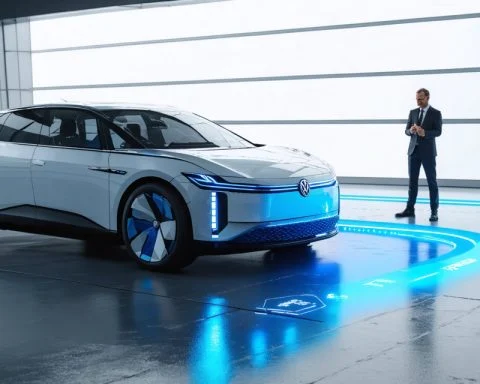- Hyundai is developing a solid-state battery pack at the Uiwang Research Center, set to be unveiled in March.
- This “dream battery” could transform the electric vehicle (EV) industry with increased energy storage and faster charging speeds.
- A prototype vehicle featuring this technology may debut this year, with mass production targeted for 2030.
- Solid-state batteries replace liquid electrolytes with solids, offering improved thermal stability, efficiency, and safety.
- Hyundai is not alone; competitors like Toyota and Honda are also exploring solid-state battery technology.
- Challenges remain, such as reducing costs and securing raw materials, similar to early electric vehicle development hurdles.
- If successful, solid-state batteries could make EVs as convenient as gasoline vehicles and support environmental sustainability.
Nestled amidst the technological bustle of South Korea, an electrifying development is set to emerge from the heart of Hyundai’s innovation hub. At the Uiwang Research Center, a whispered revolution is taking form—a solid-state battery pack that could redefine the electric vehicle landscape.
Imagine a world where the fleeting anxieties of range limitations and lengthy charging sessions dissolve into history. Hyundai’s anticipated unveiling of its first solid-state battery pack in March has enthusiasts and competitors alike brimming with curiosity. This battery, often heralded as the “dream battery,” promises the tantalizing prospect of increased energy storage and blistering charging speeds.
The automaker has constructed a pilot production line, revealing their commitment to advance EV technology. This year, a prototype vehicle equipped with this cutting-edge battery could grace the roads, signaling Hyundai’s ambition to commence mass production by 2030.
The promise of solid-state batteries lies in their innovation. By replacing the liquid electrolyte of conventional lithium-ion batteries with a solid counterpart, these new batteries offer not only greater thermal stability but faster electron movement, making them lighter, safer, and extraordinarily efficient.
While Hyundai leads the charge, other automakers like Toyota and Honda, along with several start-ups, are racing towards a solid-state future. However, challenges such as cost reduction and raw material sourcing linger. The path from traditional lithium-ion to solid-state hasn’t been easy, reminiscent of the early days of electric vehicle evolution.
Yet, if realized, these advancements could usher in an era where EVs rival gasoline vehicles in convenience while championing environmental sustainability. The potential is vast, echoing with the green promise of a cleaner horizon. Keep an eye on March—for Hyundai might just electrify the future with its groundbreaking “dream battery.”
This Revolutionary Battery Could Transform Our Future
Global Implications of Solid-State Battery Innovation
The development of solid-state batteries, as highlighted by Hyundai’s strides at the Uiwang Research Center, represents a potential seismic shift in the electric vehicle (EV) landscape. While Hyundai aims for a March unveiling, it’s crucial to examine the broader context and implications of this technology on a global scale.
1. Impact on Electric Vehicle Adoption
The transition to solid-state batteries offers myriad benefits over traditional lithium-ion batteries. One of the standout advantages is the potential for significantly increased energy density, which translates to longer driving ranges. This addresses one of the major concerns among potential EV buyers: range anxiety. Furthermore, faster charging capabilities can make electric vehicles as convenient as refueling with gasoline, removing a significant barrier to wider adoption.
2. Environmental Benefits
The move towards solid-state technology promises a cleaner future. These batteries are projected to be more efficient and environmentally friendly, with safer and more sustainable production methods. The shift could result in fewer mining requirements and the need for rare minerals, subsequently reducing the environmental impact associated with battery production.
3. Economic and Market Disruption
As Hyundai and other automakers strive for commercialization by 2030, the potential for economic shifts is immense. Countries that lead in solid-state battery innovation may dominate future markets, disrupting current automotive industry leaders. This race not only involves automakers but also technology and material companies, potentially leading to collaborations across industries.
4. Challenges and Technological Hurdles
While solid-state batteries promise a revolution, several challenges remain. Cost reduction is critical for mass adoption; current manufacturing processes are expensive and complex. Additionally, sourcing the necessary raw materials sustainably is a hurdle manufacturers must address. Progress in these areas will be vital for the dream of solid-state technology to materialize globally.
5. Potential for Wider Application
Beyond electric vehicles, the advancements in solid-state battery technology can extend to other applications. They hold promise for safer consumer electronics, more efficient renewable energy storage solutions, and even aerospace applications. The versatility of this technology could spur innovation across multiple sectors.
Important Questions and Future Outlook
– How will Hyundai’s announcement influence global auto manufacturers?
Hyundai’s success could either prompt a collaborative international effort or intensify the competition in the EV market, potentially accelerating the pace of innovation across automotive and tech industries worldwide.
– What are the potential geopolitical ramifications of a shift towards widespread solid-state battery usage?
Nations with abundant raw materials or advanced manufacturing capabilities for solid-state batteries could gain strategic advantages, altering global trade relations and possibly the geopolitical landscape.
– Can the reduction of EV production costs truly make them competitive with traditional gasoline vehicles?
A successful transition hinges on achieving cost parity or superiority with traditional vehicles. Widespread adoption will likely depend on this economic viability.
For more insights into Hyundai’s innovations and the evolving auto industry, visit the official Hyundai website through this link.












